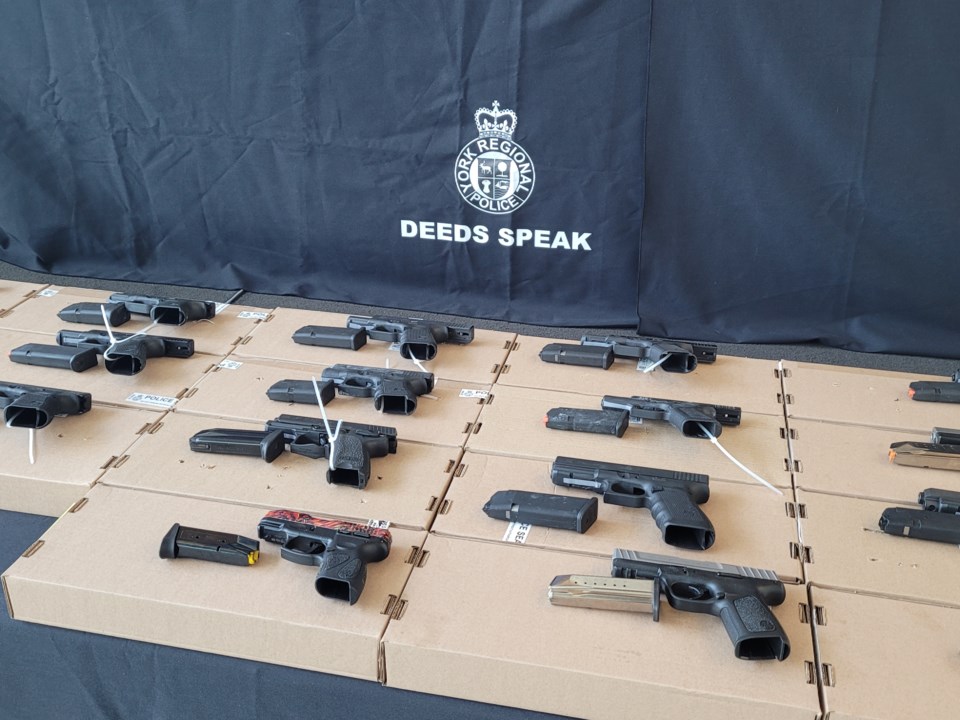A migration of Toronto gang members into more suburban areas has resulted in more than 100 gang members living in York Region, intelligence from York Regional Police said.
The migration is a result of gang members accumulating wealth through crime and having the means to buy or rent property in the suburbs, according to a report on Guns, Gangs and Violence Reduction. The report was presented by Insp. Ahmad Salhia, Det. Sgt. Rich Gaudet, intelligence analyst Sue Dunlop to the police board at its monthly meeting Nov. 7.
Intelligence shows more than 100 members of 37 different gangs are living in the region. It also highlights that there have been 32 incidents involving gang members in the region this year alone.
YRP said there has been a "marked increase in gun and gang violence across the Greater Toronto Area. Gang-related activity transcends regional borders."
So far in 2022, YRP has made 37 front-line firearm seizures and is on track to seize about 50 by the end of the year. This only accounts for guns seized during traffic stops or interactions with individuals and not through investigations.
Once a gun is seized, it is traced to determine its origins, the report said. Of the 37 guns seized on the front line, 68 per cent were traced to the U.S. while 32 per cent are unknown, which could mean the serial number was obliterated or it's still being traced.
On top of seizures, the hold-up unit seized 23 guns, of which 92 per cent were traced to the U.S. The homicide unit seized three, with one traced to the U.S., and the guns, gangs and drug enforcement unit seized 42 with 81 per cent traced to the U.S.
"Contextualized, out of 107 firearms that you see, 83 of them were successfully traced. Of those 83 guns that were traced, 100 per cent of them were identified as illicit firearms coming in from the United States and into Canada," Salhia said.
When it comes to enforcement, the report highlights Project Monarch, a multi-jurisdictional joint forces operation led by York Regional Police. It resulted in 400 charges being laid, 22 arrests, and a large number of drugs and guns seized.
It also identified a possible point of entry for illicit firearms into Canada from the U.S. at Walpole Island, a First Nation community on the St. Clair River, right across from Port Huron, Michigan in the U.S.
"At its narrowest point there's an 800 metre gap and as you can see, it's very easy for organized crime and other criminals to import illicit contraband into the country," Salhia said.
He said building partnerships with the Indigenous community there and with other police services in Ontario is key to addressing the flow of illegal firearms.
The report also touched on Bill C-21, which went into effect Oct. 22 and involves a national freeze on buying, selling and transferring handguns, limits access to firearms for people involved with domestic violence or self-harm, introduces new penalties and investigative measures, as well as some anti-smuggling measures.
While YRP said it supports any measures to enhance and protect public safety, it added that the bill doesn't go far enough to disrupt the entry of illicit firearms to Canada from the U.S.
Locally, the report said YRP will continue to combat guns, gangs, and violence through its reduction strategy which includes four pillars: intelligence, suppression, enforcement, and community mobilization.
"Anytime we can seize a gun, we know that we are saving a life," Salhia said. "Our commitment to our community will continue and is unwavering."

